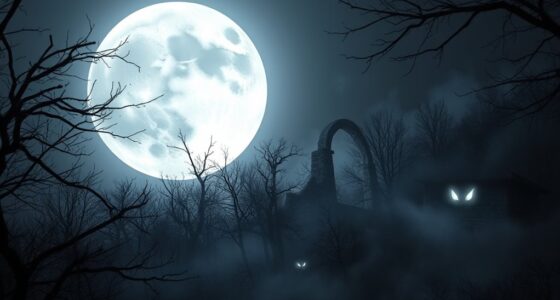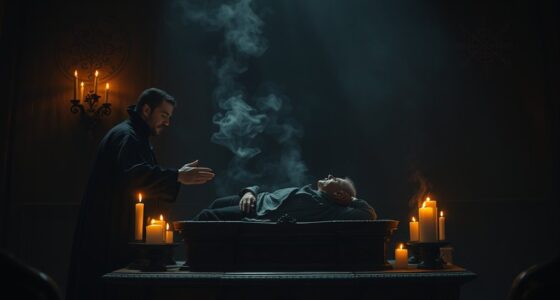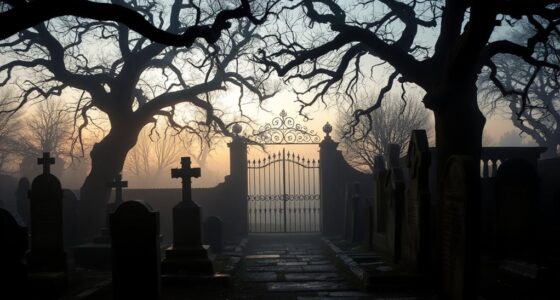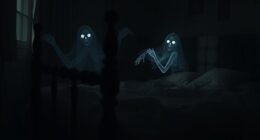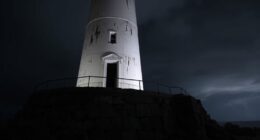The idea of 3:00 AM as the “Devil’s Hour” blends folklore, historical superstitions, and media influence, making it seem extra spooky. Many believe it’s when supernatural activity peaks because the veil between worlds thins. However, scientific explanations point to natural sleep cycles, circadian rhythms, and sleep disruptions causing waking during these hours. If you want to uncover the truth behind the myth and explore its origins, there’s more to discover below.
Key Takeaways
- The “Devil’s Hour” is rooted in cultural beliefs linking 3:00 AM to supernatural activity and spiritual portals.
- Scientific explanations attribute wakefulness at this time to sleep cycle disruptions, hormones, and stress.
- Media and horror culture amplify fears, portraying 3:00 AM as a time of demons and paranormal phenomena.
- Sleep paralysis and circadian dips can cause hallucinations and feelings of unease around this hour.
- The hype largely stems from folklore and media, with little scientific evidence supporting supernatural significance.
The Origins of the “Devil’s Hour” Myth
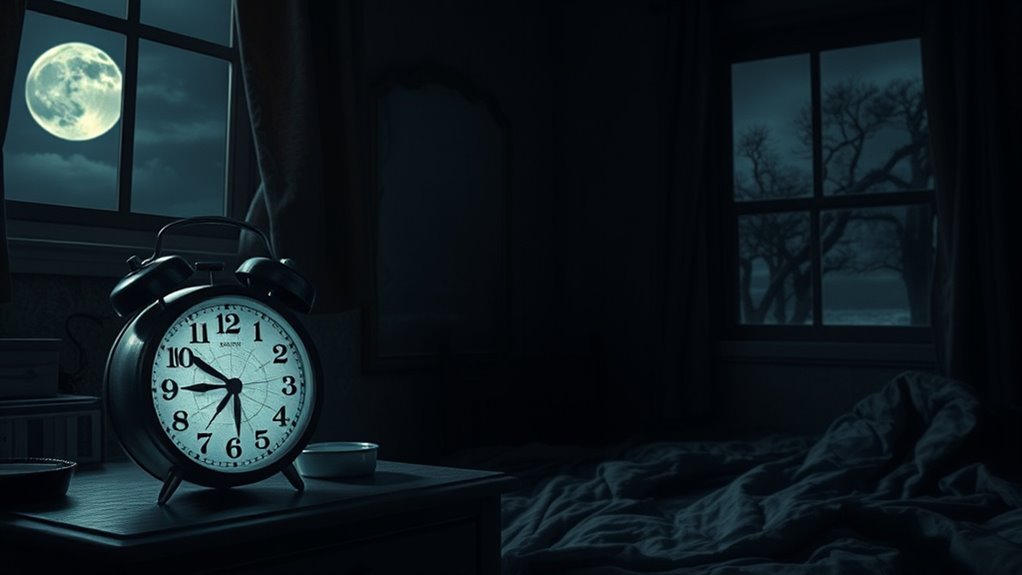
The idea of the “Devil’s Hour” being particularly sinister dates back to various cultural and religious beliefs about the time around 3:00 AM. Historically, this hour is linked to spiritual beliefs that suggest it’s when supernatural activity peaks. Additionally, some interpret the time as a period when the veil between worlds is thinnest, fueling fears rooted in supernatural activity. However, the myth also influences modern perceptions of sleep hygiene, causing some to worry about waking at this time. You might find that focusing on meditation benefits can help improve your sleep, making it easier to stay asleep through the night. By establishing a calming bedtime routine, you reduce anxiety about the hour and promote healthier sleep patterns. While the myth persists, understanding its origins helps you separate fact from fiction, encouraging better sleep habits instead of unnecessary fear.
Cultural Significance and Folklore Surrounding 3:00 AM
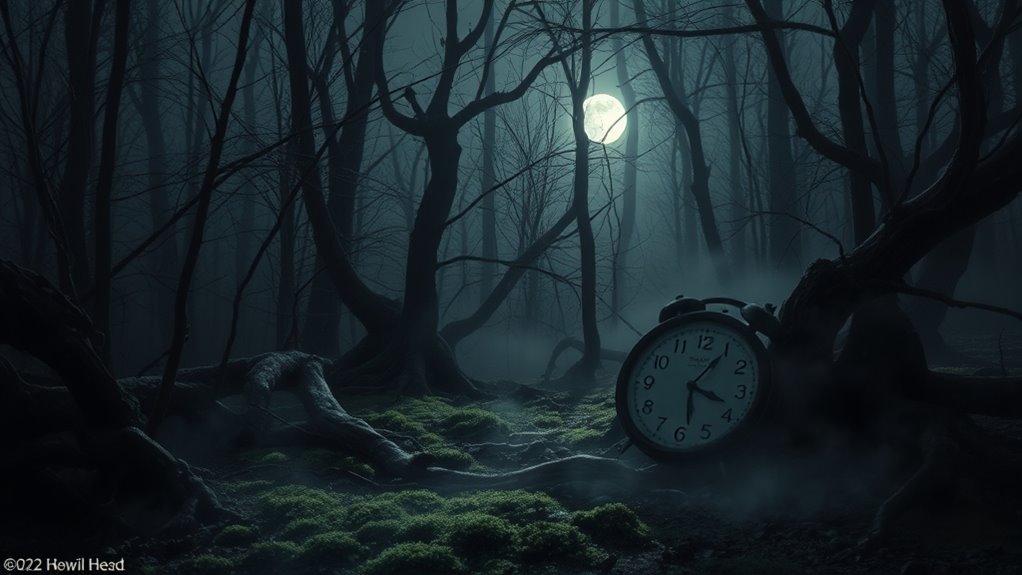
Throughout history, 3:00 AM has been steeped in folklore and cultural beliefs that label it as an especially powerful or ominous hour. In many cultures, this time symbolizes a portal between the living and supernatural folklore worlds, where spirits are believed to be most active. It holds cultural symbolism as a moment of heightened spiritual energy, often associated with supernatural occurrences or divine intervention. People have traditionally regarded this time as significant in various rituals and superstitions, which often include specific practices to ward off negative energies. This cultural perception fuels stories of ghostly encounters, spiritual awakenings, and mystical phenomena, reinforcing its reputation as a mysterious and influential hour. Additionally, supernatural folklore often depicts 3:00 AM as a prime time for paranormal activity, further cementing its mystique. Some researchers suggest that cultural symbolism surrounding this hour may also be influenced by sleep patterns and the natural circadian rhythm, which can heighten perceptions of the unknown. The idea of this hour being linked to sleep cycles and subconscious states could explain why it’s so prominent in stories and beliefs. Interestingly, the psychological effects of sleep deprivation can also contribute to heightened fears and hallucinations during this time. Moreover, scientific studies on sleep deprivation reveal that hallucinations and paranoia can occur more frequently during late-night awakenings, adding a psychological layer to the folklore. Whether real or myth, the folklore surrounding 3:00 AM continues to captivate and intrigue across cultures.
Historical Beliefs and Superstitions Linked to Late Night Hours
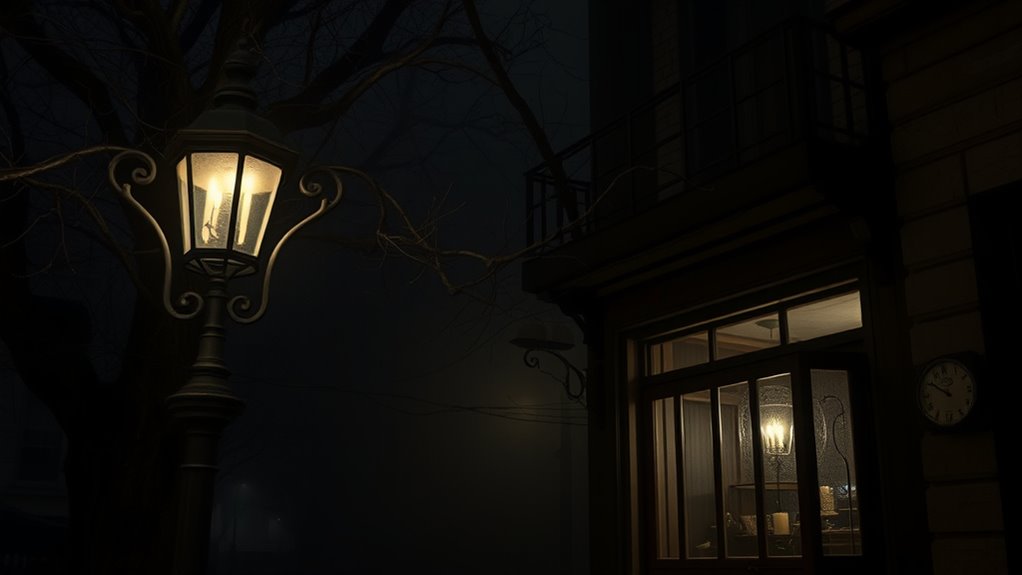
Many cultures have long held that late-night hours, especially around midnight and early dawn, carry special significance and are shrouded in superstition. During these times, people believed supernatural encounters were more likely to occur, fueling fears of spirits and ghosts. Midnight rituals, such as lighting candles or reciting prayers, were performed to ward off evil spirits or seek protection. In some traditions, these hours were thought to be when the veil between the living and the dead was thinnest, making supernatural encounters more probable. These beliefs reinforced the idea that late-night hours held a unique power, prompting caution and ritualistic behavior. Over centuries, these superstitions shaped cultural reactions to late-night hours, cementing their mysterious and sometimes ominous reputation. Understanding the types of candles used in these rituals, like scented candles, can provide insight into how different cultures sought protection or blessings during these times. Additionally, ritualistic practices varied widely, but often shared common themes of invoking protection or warding off malevolent spirits.
Scientific Explanations for Waking During the Wee Hours

Waking up during the early hours of the morning is often linked to biological processes and environmental factors rather than supernatural influences. Your body’s natural sleep cycles, stress levels, and hormone fluctuations can cause awakenings. Sleep paralysis, a common phenomenon, occurs when you wake during REM sleep and temporarily feel unable to move, often accompanied by hallucinations. Nocturnal anxiety, or heightened worry at night, can also disrupt your sleep, making you wake up feeling restless or fearful. These experiences are normal and part of your body’s complex sleep regulation system. Additionally, understanding sleep architecture can provide insight into why these disruptions occur and how to better manage them. Recognizing the importance of home security systems and their role in reducing nighttime anxiety can also contribute to more restful sleep. Installing reliable security measures can help alleviate worries about safety during the night. Developing healthy sleep habits and routines plays a significant role in minimizing these awakenings and achieving restorative sleep. Furthermore, being mindful of environmental factors, such as noise and light pollution, can significantly impact your sleep quality and help prevent unnecessary awakenings. Instead of attributing these wake-ups to supernatural causes, understanding these scientific explanations can help you manage and reduce their occurrence, promoting healthier, more restful sleep.
The Role of Sleep Cycles and Circadian Rhythms

Your sleep consists of different stages that cycle throughout the night, affecting how rested you feel. Circadian rhythms regulate these cycles, influencing peak alertness and deep sleep times. Understanding these processes helps explain why your sleep quality varies and why certain hours, like 3:00 AM, might feel more intense or unsettling. Additionally, disruptions in AI Security can interfere with sleep patterns by increasing stress and anxiety levels. Maintaining a consistent sleep schedule and managing environmental factors can support healthy sleep cycles and circadian rhythm regulation. Proper nutrition, including adequate intake of healthy fats, can also play a role in promoting better sleep quality.
Sleep Cycle Stages
Sleep occurs in cyclical stages that repeat throughout the night, each serving a specific purpose for physical and mental restoration. Understanding your sleep patterns helps you recognize how your body progresses through different stages, including light sleep, deep sleep, and REM sleep. During these cycles, your brain shifts from slow, restorative activity to rapid eye movement, where most dreaming happens. Dream analysis can reveal insights into your subconscious and emotional health, often occurring during REM sleep. These stages are essential for consolidating memories, repairing tissues, and maintaining overall well-being. Recognizing the timing and duration of each stage can help you optimize your sleep quality, making sure you wake refreshed and alert. Proper sleep cycle management reduces disruptions and enhances your mental clarity.
Circadian Rhythm Peaks
Have you ever wondered why you feel most alert at certain times of the day? Your biological clock, or circadian rhythm, governs these peaks and dips. These peaks happen when your body naturally releases alertness hormones like cortisol, aligning with your sleep-wake cycle. Maintaining good sleep hygiene helps keep this rhythm consistent, so you’re alert when you need to be and restful when it’s time to sleep. Understanding your circadian rhythm can clarify why late-night hours, like 3:00 AM, sometimes feel off or intense.
| Time of Day | Biological Changes | Effect on Alertness |
|---|---|---|
| Morning | Cortisol peaks, body warms | Increased alertness |
| Afternoon | Slight dip, but remains stable | Moderate alertness |
| Night | Melatonin rises, alertness drops | Sleepiness |
Impact on Sleep Quality
Since your sleep quality heavily depends on aligning your sleep cycles with your circadian rhythm, disruptions to either can lead to restless nights and reduced restfulness. Sleep disruptions during the so-called “Devil’s Hour” often feed into supernatural beliefs, making it seem more ominous than it is. Understanding how sleep cycles work helps you see that disturbances at this time can impact your rest.
- Interrupts REM sleep, affecting memory and mood.
- Alters hormone production, disrupting overall health.
- Heightens anxiety about supernatural beliefs, worsening sleep disruption.
- Reduces deep sleep stages, leaving you tired.
Media Influence and Modern Interpretations of the Time

Media has played a big role in making 3:00 AM seem more mysterious and frightening, especially through horror films and urban legends. Social media further amplifies these stories, spreading superstition and fear quickly. This creates a cycle where modern interpretations often blur the line between fact and fiction.
Media’s Role in Popularity
Media plays a crucial role in shaping the popularity of the so-called “Devil’s Hour” by amplifying its mysterious allure and fueling public curiosity. Through media sensationalism, stories about strange events at 3:00 AM spread quickly, making the hour seem more ominous. Celebrity rumors often link famous figures to supernatural experiences during this time, adding to its mystique. To capture your attention, here are four ways media influences its popularity:
- Creating sensational headlines that emphasize fear and mystery
- Sharing viral stories that blur fact and fiction
- Using celebrities to boost intrigue and credibility
- Fostering online communities that reinforce superstitions
Horror Films & Superstition
Horror films have long shaped how people perceive the so-called “Devil’s Hour,” blending superstition with entertainment to deepen its mystique. They often depict this time as filled with supernatural symbolism—ghosts, demons, and dark forces lurking in the shadows. These movies reinforce ideas that midnight rituals and mystical events occur at 3:00 AM, fueling fears and myths. By dramatizing these themes, filmmakers influence modern interpretations of the hour, making it seem more ominous than it really is. Below is a comparison of common themes:
| Supernatural Symbolism | Midnight Rituals |
|---|---|
| Demonic possession | Incantations at 3 AM |
| Ghostly apparitions | Rituals for protection |
| Dark entities | Sacrifices or offerings |
| Cursed objects | Midnight prayers |
Social Media’s Amplification
Social media has dramatically amplified the myths and fears surrounding the so-called “Devil’s Hour.” Platforms like TikTok, Instagram, and YouTube spread stories, challenges, and supposed encounters that reinforce supernatural beliefs tied to 3:00 AM. This often fuels sleep deprivation and nocturnal anxiety, making it harder to distinguish fact from fiction. To grab your attention, here are four ways social media influences perceptions of the Devil’s Hour:
- Viral stories claiming supernatural sightings at 3:00 AM
- Challenges encouraging risky behaviors during the hour
- Influencers sharing personal ghost encounters
- Memes and videos linking the time to demonic activity
All these elements hype the hour, blurring reality and heightening fears rooted in modern media.
Psychological Factors and the Power of Suggestion

The power of suggestion plays a significant role in shaping your perception of the so-called Devil’s Hour. When you hear stories or see images linked to 3:00 AM, your mind becomes more receptive to fear and superstition reinforcement. Sleep paralysis, for instance, often occurs during this time, fueling feelings of dread and hallucinations that seem to confirm supernatural explanations. Your subconscious picks up these cues, making you more likely to interpret normal body sensations as frightening. This cycle deepens your belief in the hour’s ominous significance. Here’s how emotions are influenced:
| Emotion | Trigger | Result |
|---|---|---|
| Fear | Sleep paralysis hallucinations | Increased anxiety |
| Superstition | Cultural stories about 3 AM | Reinforced beliefs |
| Anxiety | Unexplained sensations | Heightened alertness |
| Curiosity | Mysterious stories and myths | Desire for explanations |
Real Experiences or Urban Legends: Separating Fact From Fiction
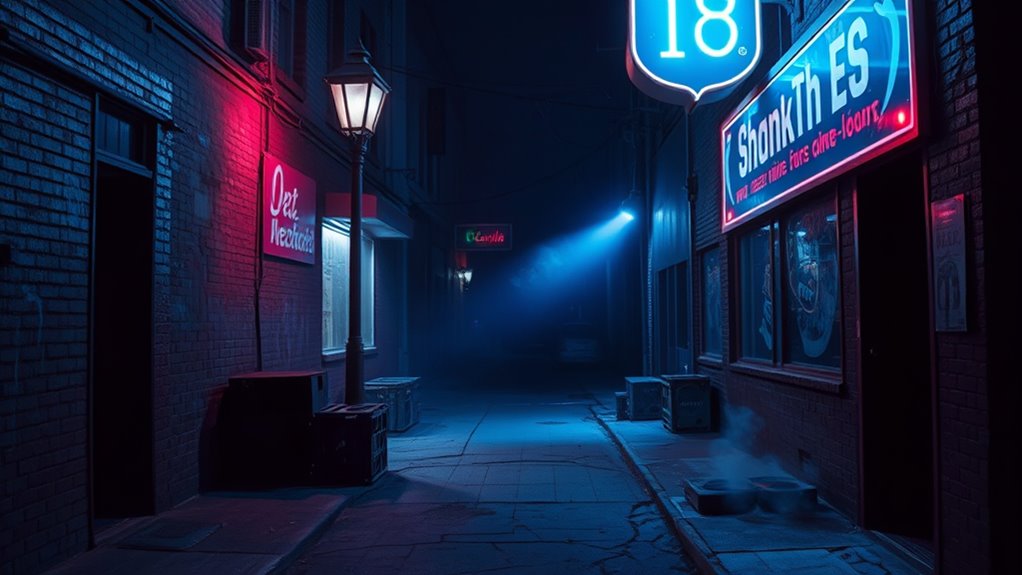
Many claims about the 3:00 AM hour blend fact and fiction, making it hard to distinguish reality from myth. You might hear stories of sleep paralysis episodes, where you wake up unable to move, feeling a chilling presence. Urban legends often link these experiences to supernatural entities or demonic visits during this hour. To help you separate fact from fiction, consider these points:
- Sleep paralysis is a real phenomenon caused by disrupted sleep cycles.
- Urban legends fuel stories of malevolent spirits lurking during the Devil’s Hour.
- Scientific research suggests psychological factors, like fear and suggestion, intensify these experiences.
- Most “hauntings” at 3:00 AM have logical, natural explanations, not supernatural ones.
Understanding these facts helps you see beyond urban legends and recognize genuine physiological experiences.
Frequently Asked Questions
Has Any Scientific Evidence Proven 3:00 AM Is Inherently More Sinister?
You wonder if 3:00 AM is inherently more sinister. Scientific research shows no evidence that this time has supernatural significance. Many supernatural beliefs link 3:00 AM to spooky events, but these are cultural stories rather than facts. Your mind might associate this hour with fear, but science suggests it’s just a myth. Trust scientific research over superstitions, and remember that fear often comes from perception, not reality.
Are There Specific Cultures Where 3:00 AM Is Considered a Sacred or Lucky Time?
Imagine a clock striking 3:00 AM, seen as a moment of spiritual significance in some cultures. In Hindu traditions, this time is considered sacred, symbolizing a shift between night and dawn, a time for meditation and reflection. Cultural beliefs shape how people interpret this hour, with some viewing it as a source of luck or divine connection. Your perception depends on the spiritual significance your culture assigns to this time.
How Do Sleep Disorders Influence Perceptions of the “Devil’S Hour”?
You might notice that sleep disorders like sleep paralysis and night terrors heighten your perception of the “devil’s hour.” When you experience these conditions, especially around 3:00 AM, your anxiety and fear increase, making it seem more threatening. Sleep paralysis can cause hallucinations, and night terrors intensify feelings of dread. These experiences distort reality, making the hour seem more sinister, even though it’s just a natural part of disrupted sleep cycles.
Can Technological Devices Affect Our Perception of Being Awake at 3:00 AM?
You might think that technological devices don’t influence your perception of being awake at 3:00 am, but they can cause circadian disruption, making you feel more alert or confused about your sleep cycle. Sleep technology, like screens emitting blue light, interferes with melatonin production, which can make you feel awake during the night. This disruption alters your perception, making you more likely to associate late-night wakefulness with the “Devil’s Hour.”
What Role Do Personal Nightmares Play in Reinforcing the “Devil’S Hour” Myth?
Nightmares influence your perception by tapping into subconscious fears, reinforcing myths like the “devil’s hour.” As you wake from disturbing dreams, your mind fixates on the eerie hour, strengthening the myth. Nightmares influence your thoughts, shape your beliefs, and deepen your fears. They create a cycle where subconscious fears feed the legend, making 3:00 am seem more sinister, even when there’s no real threat.
Conclusion
So, when the clock strikes 3:00 am, don’t let the devil’s doubts dominate your dreams. Immerse yourself in the dynamics of dawn and darkness, dispelling the dread with facts and understanding. Whether it’s folklore, fear, or fiction, remember that science and skepticism shine brighter than superstitions. Embrace the evening’s eerie enigma with an open mind, knowing that the true truth lies beyond the haunting headlines and hysterical hype.



